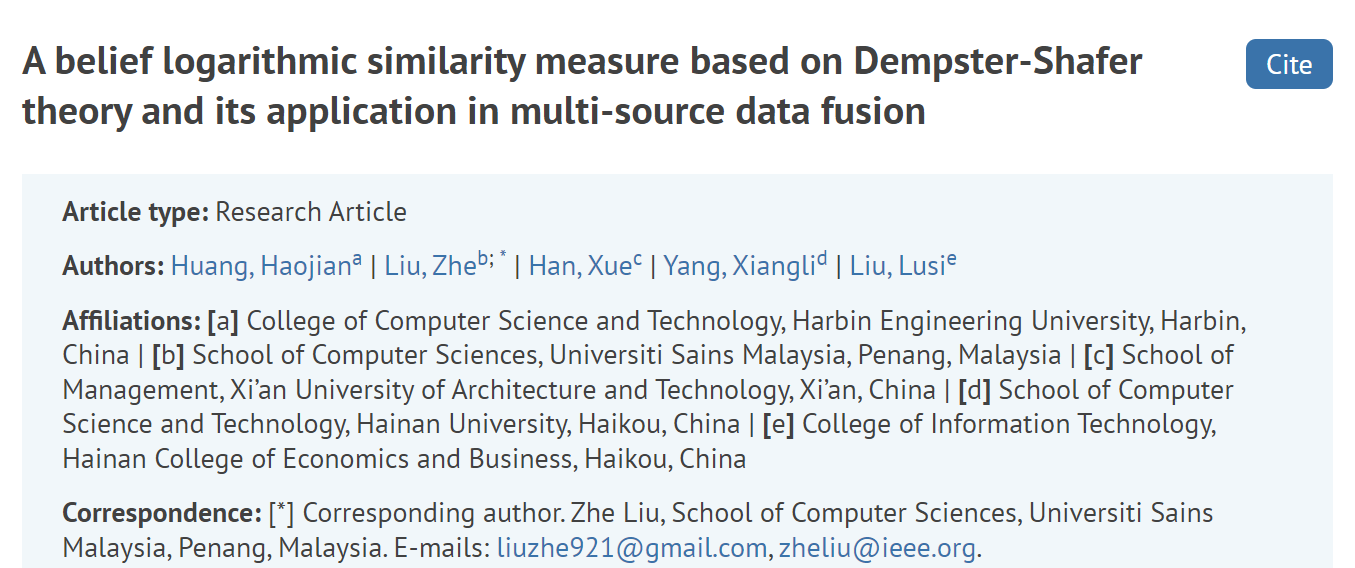????????????????
欢迎来到本博客
❤️❤️????????
????博主优势:
????????????
博客内容尽量做到思维缜密,逻辑清晰,为了方便读者。
⛳️
座右铭:
行百里者,半于九十。
????????????
本文目录如下:
????????????
目录
????1 概述
????2 运行结果
????3 参考文献
????4 Matlab代码实现
????1 概述
文献:

基于Dempster-Shafer理论的信念对数相似度测量及其在多源数据融合中的应用
摘要:Dempster-Shafer理论(DST)由于其在处理不确定和不精确信息方面的强大优势而在许多领域引起了广泛关注。然而,一旦Dempster的规则面对高度冲突的证据,可能会产生直观上令人困惑的结果。为了解决这一缺陷,本文提出了一种基于DST的新的信念对数相似度测量(BLSM)。此外,我们进一步提出了一种增强的信念对数相似度测量(EBLSM)来考虑子集的内部差异。同时,我们证明了EBLSM满足一些理想的性质,如有界性、对称性和非退化性。最后,我们设计了一种基于EBLSM的新的多源数据融合方法。通过在故障诊断和目标识别两个应用案例中表现出最佳性能,充分展示了所提出方法的合理性和有效性。
关键词:Dempster-Shafer理论,基本信念赋值,对数相似度测量,信念熵,数据融合
????
2 运行结果



部分代码:
%% Data set from
% 2022 -A generalized χ 2 divergence for multisource
% information fusion and its application in
% fault diagnosis
%
G = [1,0,0;0,1,0;0,0,1;1,1,1];
F = sum(G,2);cluster = 3;
M = [0.7,0.1,0,0.2;
0.7,0,0,0.3;
0.65,0.15,0,0.2;
0.75,0,0.05,0.2;
0,0.2,0.8,0];
M = M(1:4,:);
%% Iris
% G = [1,0,0;0,1,0;0,0,1;1,1,0;1,0,1;0,1,1;1,1,1];
% F = sum(G,2); cluster = 3;
% M = [0.3337,0.3165,0.2816,0.0307,0.0052,0.0272,0.0052;
% 0.3164,0.2501,0.2732,0.0304,0.0481,0.0515,0.0304;
% 0.6699,0.2374,0.0884,0,0,0.0043,0;
% 0.6996,0.2120,0.0658,0,0,0.0226,0];
%% Iris with noise
% G = [1,0,0;0,1,0;0,0,1;1,1,0;1,0,1;0,1,1;1,1,1];
% F = sum(G,2); cluster = 3;
% M = [0.3337,0.3165,0.2816,0.0307,0.0052,0.0272,0.0052;
% 0,0.99,0.01,0,0,0,0;
% 0.6699,0.2374,0.0884,0,0,0.0043,0;
% 0.6996,0.2120,0.0658,0,0,0.0226,0];
%% Data Set from
% 2022 Enhanced mass Jensen–Shannon divergence for information fusion
% G = [1,0,0;0,1,0;0,0,1;1,1,1];
% F = sum(G,2);cluster = 3;
% M = [0.4,0.6,0,0;
% 0,0.7,0.3,0;
% 0.85,0,0,0.15;
% 0.4,0.6,0,0;
% 0.75,0,0,0.25];
% M = M(1:5,:);
%% Data Set from
% 2018-Multisensor Fault Diagnosis Modeling Based on the Evidence Theory
% G = [1,0,0;0,1,0;0,0,1;1,1,1];
% F = sum(G,2);cluster = 3;
% M = [0.7,0.15,0.15,0;
% 0.4,0.2,0.4,0;
% 0.65,0.35,0,0;
% 0.75,0,0.25,0;
% 0,0.2,0.8,0];
%% Data Set from
% 2018-A correlation coefficient for belief functions
% G = [1,0,0,0;0,1,0,0;0,0,1,0;0,0,0,1;1,1,1,1];
% F = sum(G,2);cluster = 4;
% M = [0.06,0.68,0.02,0.04,0.20;
% 0.02,0,0.79,0.05,0.14;
% 0.02,0.58,0.16,0.04,0.20];
%% Data Set from
% 2020-A new divergence measure for belief functions in D–S
% evidence theory for multisensor data fusion
% G = [1,0,0;0,1,0;0,0,1;1,0,1];
% F = sum(G,2); cluster = 3;
% M = [0.4,0.28,0.3,0.02;
% 0.01,0.9,0.08,0.01;
% 0.63,0.06,0.01,0.3;
% 0.6,0.09,0.01,0.3;
% 0.6,0.09,0.01,0.3;];
%% Data Set from
% 2019 Multi-sensor data fusion based on the belief divergence measure of
% evidences and the belief entropy
% G = [1,0,0;0,1,0;0,0,1;1,0,1];
% F = sum(G,2);cluster = 3;
% M = [0.41,0.29,0.3,0;
% 0,0.9,0.1,0;
% 0.58,0.07,0,0.35;
% 0.55,0.10,0,0.35;
% 0.6,0.1,0,0.3;];
% G = [1,0,0;0,1,0;0,1,1;1,1,1];
% F = sum(G,2);cluster = 3;
% M = [0.6,0.1,0.1,0.2;0.05,0.8,0.05,0.10;0.7,0.1,0.1,0.1;];
% %% Data Set from
% % An Improved Multi-Source Data Fusion Method
% % Based on the Belief Entropy and Divergence Measure
%
% G = [1,0,0;0,1,0;0,0,1;1,0,1];
% F = sum(G,2);cluster = 3;
% M = [0.41,0.29,0.3,0;
% 0,0.9,0.1,0;
% 0.58,0.07,0,0.35;
% 0.55,0.1,0,0.35;
% 0.6,0.1,0,0.3;];
%% D-S Fusion
res = M(1,:);res_step = [];
for i = 2:size(M,1)
K = 0;
A = zeros(1,size(M,2));
for j = 1:size(M,2) % 计算第j列交集的信任值
for k = 1:size(M,2)
flag = G(j,:) .* G(k,:);
if sum(flag) >=1
for p = 1:size(G,1)
if sum(flag==G(p,:))== cluster %找到完全匹配的类别进行计算
A(p) = A(p) + res(j)*M(i,k);
break % 每次只会唯一对应一个
end
end
elseif sum(flag)==0 %交集完全为空的类别计算K
K = K + res(j)*M(i,k);
end
end
end
res = 1/(1-K).*A;
res_step = [res_step;res];
end
Python代码可视化:
import matplotlib.pyplot as plt
x = ['Dempster','Murphy','Deng et.al','Lin et.al','Jiang','Xiao','Gao and Xiao','Proposed']
y = [0,0.7273,0.7261,0.6901,0.7328,0.8393,0.8504,0.8759]
font = {'family': 'serif',
'serif': 'Times New Roman',
'weight': 'normal',
'size': 12}
plt.rc('font', **font)
plt.figure(dpi=1200,figsize=[6,7.5])
plt.bar(x,y,color=['magenta','blue','deepskyblue','cyan','lime','yellow','gold','red'],alpha=0.9,label=['DS','Murphy','Deng','Lin','W.Jiang','F.Xiao','X.Gao','The proposed method']) #指定不同颜色并设置透明度
# plt.xlabel('Combination Methods')
plt.xticks(rotation=45) # 倾斜70度
plt.ylabel('Mass of belief')
# plt.legend(['DS','Murphy','Deng','Lin','W.Jiang','F.Xiao','X.Gao','The proposed method'],
# ncol=1, # 图例要排成多少列
# loc=2, # 图例的中心点
# bbox_to_anchor=(1.01, 1.0), # 偏移的百分比
# borderaxespad=0.,
# fontsize=12,
# title="Combination Methods") # 图例标题
# plt.legend()
plt.savefig("application.jpg")
plt.show()
????3
参考文献
文章中一些内容引自网络,会注明出处或引用为参考文献,难免有未尽之处,如有不妥,请随时联系删除。

https://content.iospress.com/articles/journal-of-intelligent-and-fuzzy-systems/ifs230207
A belief logarithmic similarity measure based on Dempster-Shafer theory and its application in multi-source data fusion - IOS Press
????
4 Matlab代码
实现